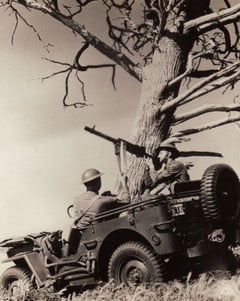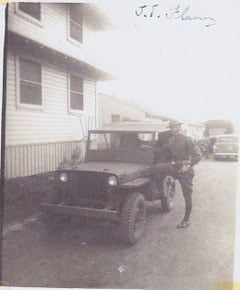Jeep
The Army and Cavalry in 1932 were looking for a support vehicle to transport light materials for the troops. They first looked at a small two seater pick-up truck built by American Austin which was being used in Great Britain. However the project did not gain much steam because of Americas isolation policies until 1940. A commission was formed to study the question.
The war in Europe was speeding up and there was not time to waste. At Bantam and Willys-Overland everyone was on a war footing. On July 22, 1940, sent plans of its prototype to the Army. Willys-Overland provided a more attractive price but it could not meet the delivery deadline the Army had demanded.
There for the Army purchased the plans and signed the contract on July 25, 1940, for what would become the iconic Jeep. Extensive testing begun of the Bantam prototype.
The only other competitor was Willys-Overland and even though they did not produce a prototype the Army invited them to watch the Bantam test. It was at that point that Ford entered the picture. Even though Ford had not entered any plans was intrigue by the project and had a massive production facility. The Army concluded that Ford’s production facility would be able to offer faster assembly and lower cost so they let the Ford engineers look at the Bantam plans.
In the end the Army awarded contracts to Bantam, Ford and Willys. Willys and Ford presented the Army with prototypes on November 11,1940. They were basically identical copies of the Bantam prototype with the following exceptions. The Willys had a larger 60hp engine but was much heavier and the Ford had a feeble tractor engine but has a gigantic projection facility. In the end Willys was given the first order of 16,000 units of their MB series on July 31, 1941. On August 4, 1941, the order was upped to 18,600 units.
Ford had not given up and after working with the War Department the Ford GP was found to compliment the Willys MB and could answer the coming production demands as the war was looming to engulf the world.
Willys finding themselves looking like they would be pushed out of the race like Bantam. Willys proposed an association with Ford and granted the government a non-exclusive license to allow Ford to manufacture the vehicles using Willys specifications and plans. The Quartermaster jumped on the offer and immediately ordered 15,000 Ford MBs.
Production of the MB started at Willys-Overland on November 18, 1941, and Ford started in February 1942. On January 13,1942 Ford started production of the GPW series.
There is much more to this story having to do with further modifications, accessories and of course battle field modifications. A great book about the jeep is “The Jeep History of a World War II Legend, by David Dalet and Christophe Le Bitoux.
One of the most interesting questions is the origin of the name Jeep. The problem isn’t finding an answer, but finding the correct answer. The most serious referred to “Eugene the Jeep” Popeye’s faithful companion. The term Jeep was first used in an article by Katherine Hillyer from the Washington Daily News on March 16, 1941, before production even started. The first reference had to do with an artillery tractor produced by the Minneapolis-Moline Company. The tractor was sent to trials and a solider with the 109th Ordnance Corps nicknamed it “jeep,” then made a comment about Eugene the Jeep.
Once the Bantam prototype was sent to the testing grounds word spread about this amazing 1/4 ton reconnaissance vehicle made by Bantam and the press , impressed by its prowess of the small vehicle baptized it Jeep in their articles.
The first references of the Jeep and the 107th appear in 1942 when the 107th lost its horses and became a mechanized unit.





